“The Immunity Syndrome”
Written by Robert Sabaroff
Directed by Joseph Pevney
Season 2, Episode 19
Production episode 60348
Original air date: January 19, 1968
Stardate: 4307.1
Captain’s log. While en route to Starbase 6 for some desperately needed R&R, Uhura gets a static-filled message from Starbase 6, with only the words “Intrepid” and a set of coordinates. The Intrepid is a ship entirely staffed by Vulcans. While Uhura tries to raise the starbase, Spock becomes overwhelmed—he has telepathically felt the entire crew of the Intrepid die.
As McCoy takes Spock to sickbay, Uhura gets through to the starbase. The Enterprise is ordered to the Gamma VII system, which the Intrepid was investigating. They’ve lost all contact with the Intrepid. Chekov does a long-range scan, only to find that the system—which is inhabited with a thriving star—is completely dead.
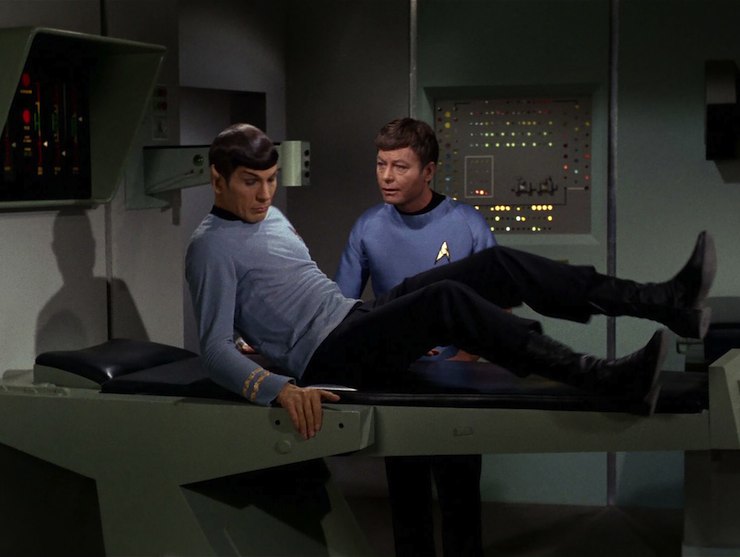
McCoy examines Spock and finds nothing wrong. The pain was momentary, but he definitely felt all four hundred Vulcans on the Intrepid die. He returns to duty just as they arrive at Gamma VII. Uhura has lost all contact with the starbase because of the interference, which seems to be coming from an energy reading Spock can’t analyze. It looks like a hole in space where the system (and the Intrepid) should be.
Kirk has Chekov launch a probe, but a loud noise blares through the ship and destroys the probe. But Uhura almost faints, Chekov seems dizzy, and McCoy reports that half the crew has fainted and is suddenly cranky and dizzy and irritable. And the crew was already exhausted going into this mission, that’s why they were headed for R&R.
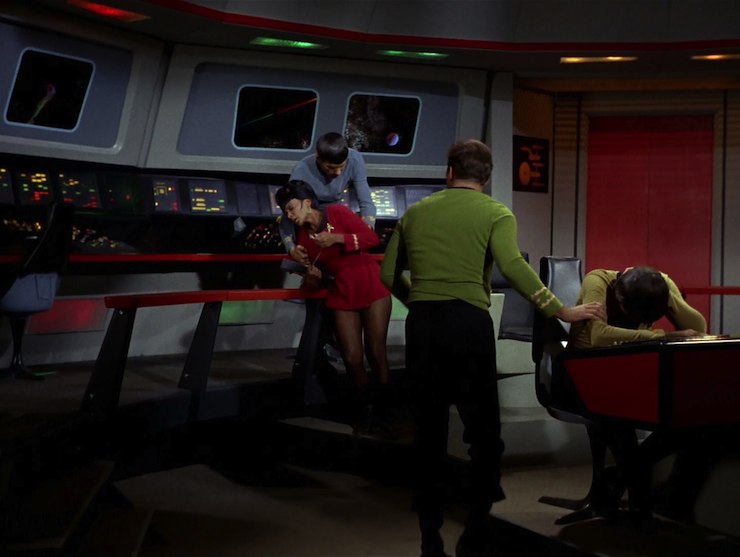
Spock has insufficient data for analysis. It is neither solid, liquid, nor gas, but it did activate the deflectors, so it must be some kind of energy, but not one that the computer recognizes.
Kirk has Kyle approach the zone of darkness, and then the noise comes back. After a few moments, the noise stops—but then the stars disappear. Somehow they have entered the zone of darkness despite not moving. However, they lost five percent of their energy reserves, and Scotty has no idea how or why. McCoy reports that two thirds of the crew is being affected by whatever is making people faint. He and Chapel apply stimulants to the crew.
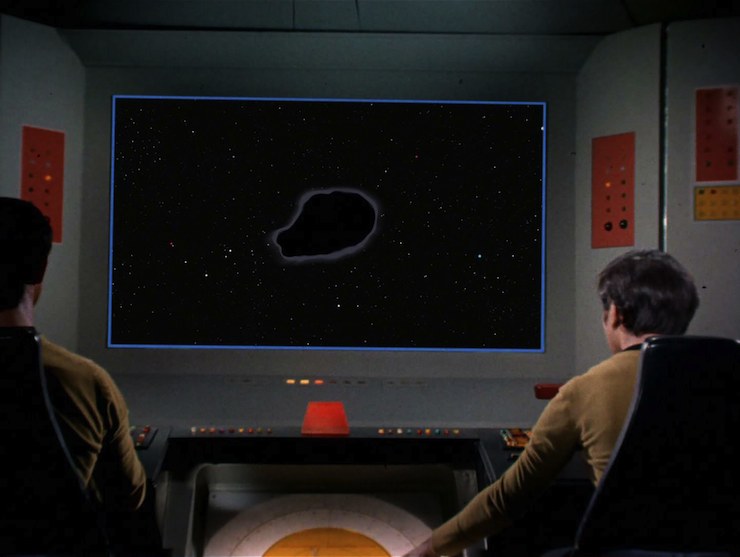
Opening intership, Kirk gives a pep talk to all personnel, hoping to inspire them to do their jobs despite the exhaustion and stuff. Right after that, just to negate the effect of it, McCoy reports that the energy levels of everyone in the crew is dropping—the whole crew is dying. And that same energy drain is affecting the ship.
The ship is being pulled toward the center of the zone of darkness. Scotty tries to apply reverse thrust, and the ship moves forward. Spock suggests applying forward thrust, and Scotty reluctantly does so—and it works! They’re still moving forward, but more slowly.
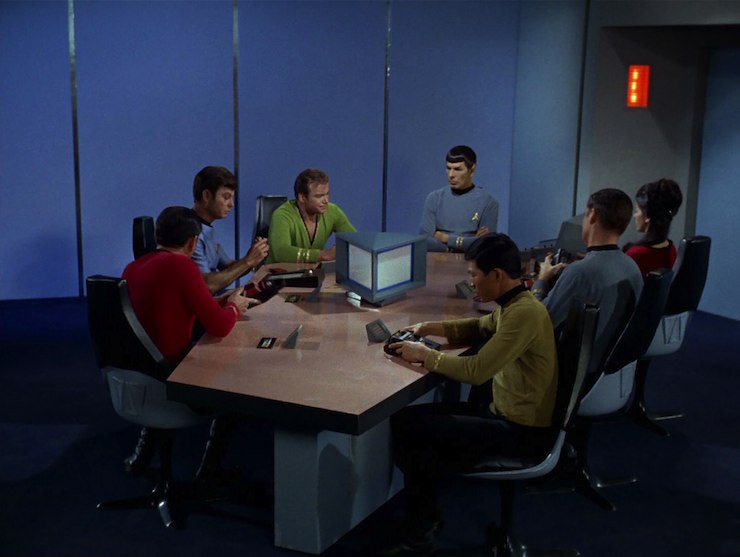
In the briefing room, McCoy reports that the stimulants are helping, but everyone’s still dying. Scotty says that all ship’s functions are working backwards for some reason. Kirk orders Scotty to put all the ship’s power into one big-ass thrust forward in the hopes that it will snap them back out of the zone. Spock also hypothesizes that the zone itself isn’t causing the power drain, but something else inside it.
Spock is concerned that the Intrepid would have done all this stuff, too, but Kirk points out that the sheer illogic of the situation might have vexed the Vulcan crew.
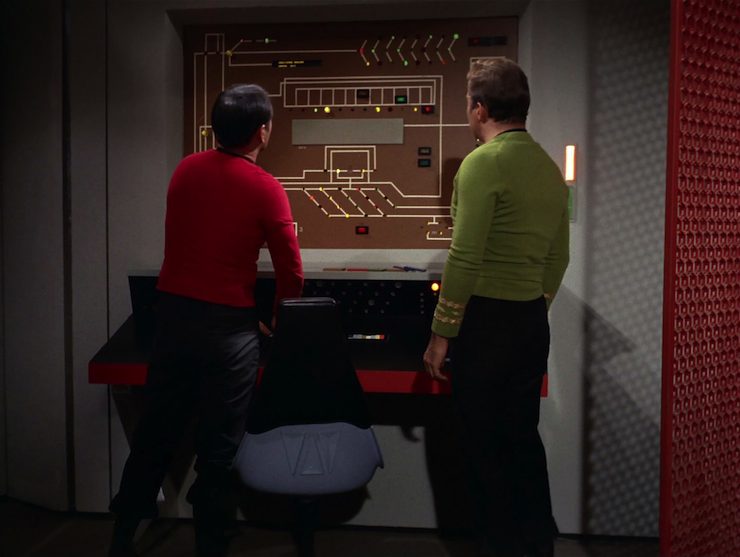
Scotty channels all the power into the forward burst, but all it does is allow them to maintain position. At this point, they’ve got two hours of power left.
And then the heart of the zone of darkness reveals itself as it approaches. It looks like a giant space amoeba, and Spock confirms that it’s the source of the energy drain. Chekov launches another probe. Spock reports that it is alive, and it is drawing the Enterprise to its death the same way it drew the Intrepid.
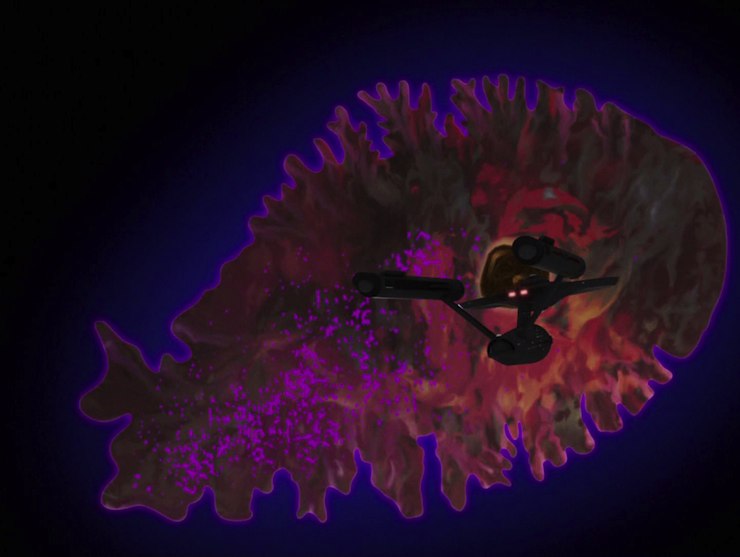
McCoy verifies that it is an amoeba—it’s an even simpler life form than the more normal microscopic amoeba they’re used to. They need more information, and the probes can only tell them so much, and they dare not take the ship closer to the amoeba and risk losing power faster.
Both Spock and McCoy recommend taking a shuttlecraft to probe the amoeba and find its vulnerable spots. They also both volunteer to be the pilot, even though it may be a suicide mission. McCoy has already done the preliminary research, and he’s the biology expert; Spock believes he can assess the data more objectively and rationally. Kirk must choose one of them to take on the mission.
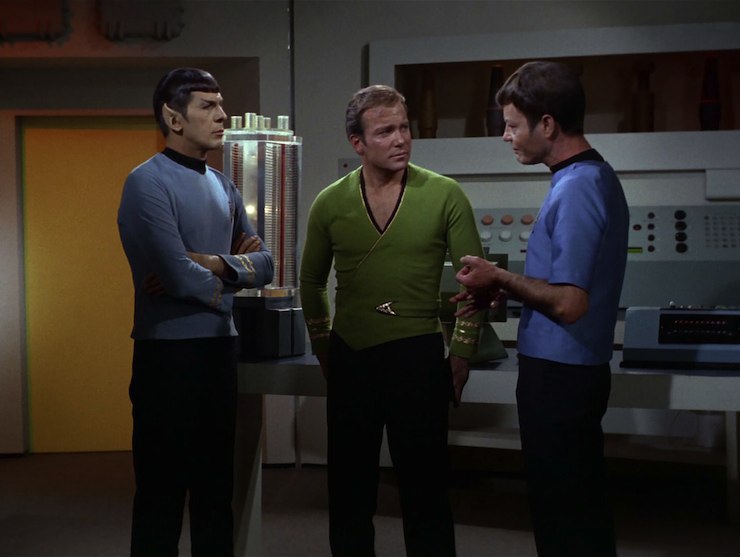
It’s a difficult, impossible choice, as he must condemn one of his two closest friends to death. Both are qualified, but ultimately he gives it to Spock. McCoy equips the shuttle with everything he’ll need.
Spock penetrates the amoeba’s structure, and determines that it has stored enough energy for reproduction. Spock reduces life support to bare minimum in the hopes of having enough power to get back. Uhura picks up a weak signal from Spock, saying that the amoeba can be destroyed from the inside only, as the outer membrane protects it.
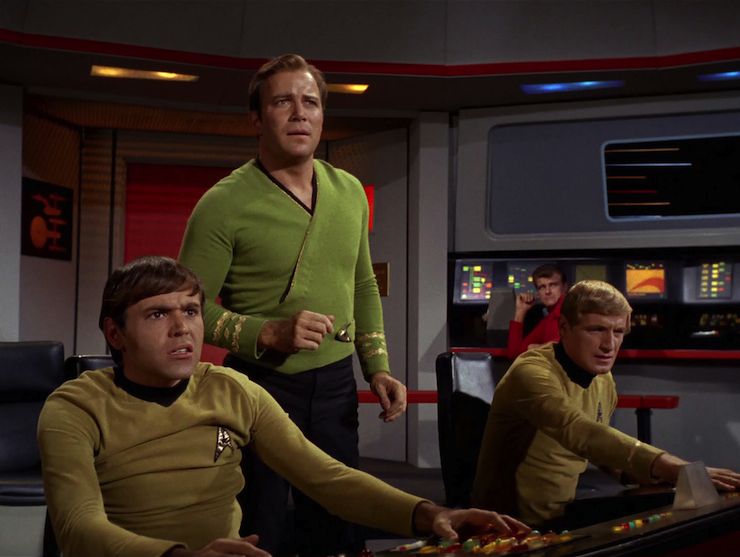
Kirk orders Scotty to cut the thrust, and divert all power to shields. He wants the ship to be drawn inside so they can act as an antibody to this amoeba that appears to be a galactic virus. They have to stop it before it reproduces. Since everything seems to work in reverse, Kirk orders Scotty to prepare a magnetic bottle with antimatter, which is the only form of energy this thing is likely not to eat.
After recording a log recommending commendations to McCoy, Scotty, Uhura, Kyle, and Chekov, and a posthumous commendation for Spock, Kirk orders the antimatter bomb to be dropped in the nucleus. It’s on a seven-minute delayed detonation, and Chekov says they’re just over six minutes out.
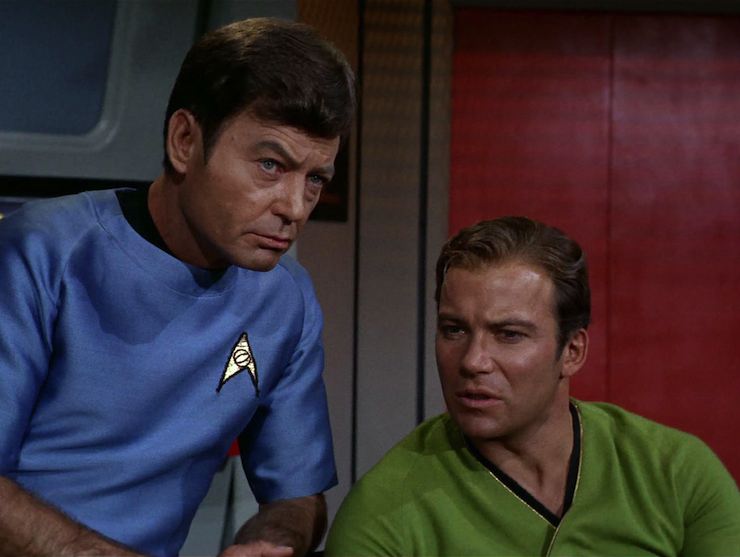
They detect Spock’s shuttle, and despite both Spock and Scotty recommending against it, Kirk orders a tractor beam on the shuttle. Power goes dead, but inertia carries them out of the amoeba’s membrane. The explosion destroys the amoeba, and power is restored to both the Enterprise and the shuttlecraft.
Once the shuttlecraft is back on board, Kirk has Chekov set a course for Starbase 6 for a now really really desperately needed R&R.
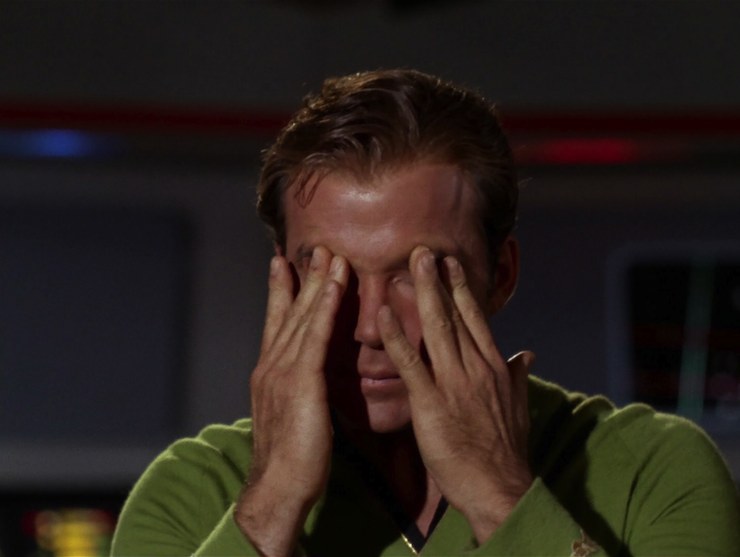
Can’t we just reverse the polarity? The space amoeba is eleven thousand miles long, width varying from two to three thousand miles, its outer layer is studded with space debris and waste, while the interior consists of protoplasm. That’s a big Twinkie….
Fascinating. Though Vulcans are touch telepaths, the death of four hundred can be felt over light-years. Spock also has a rare moment of sentiment, recording a personal log that commends the crew of the Enterprise, calling them the finest crew in the fleet.
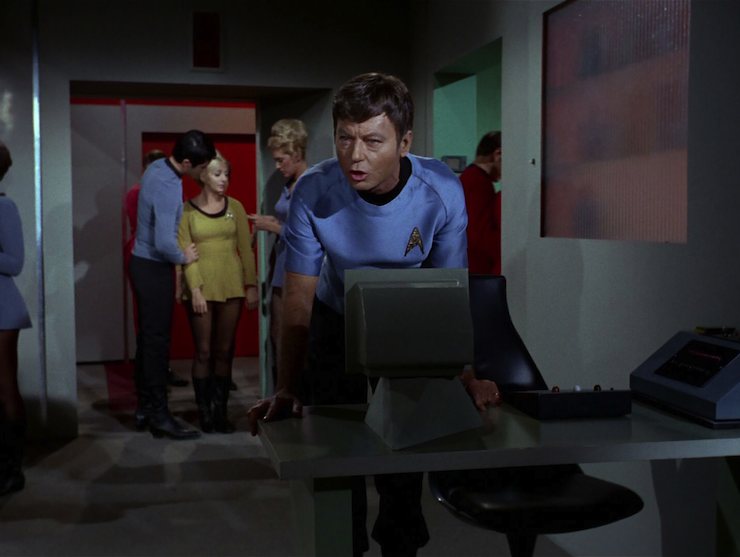
I’m a doctor not an escalator. McCoy is eager to be the one to investigate the amoeba as it’s a biological discovery of great value. He’s very cranky about the fact that Spock gets to go instead.
Hailing frequencies open. Uhura has to constantly fight her own dizziness and the interference put out by the amoeba in order to get communications to work.
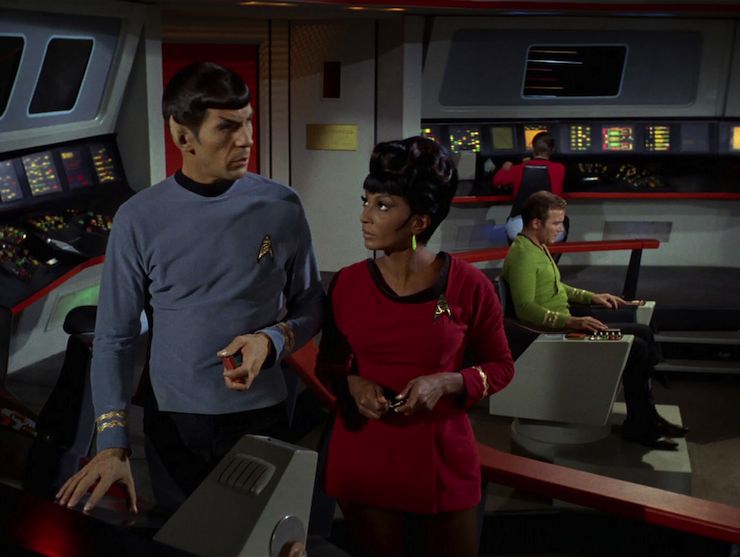
I cannot change the laws of physics! Scotty is his usual can-do self, constantly telling Kirk what a bad idea things are and how badly they can go wrong and such.
It’s a Russian invention. When they penetrate the amoeba, Chekov triumphantly cries, “We’re through, sir!” and Kirk snottily tells him that they’re all aware of that. Give the kid a break, Jim, he was excited!
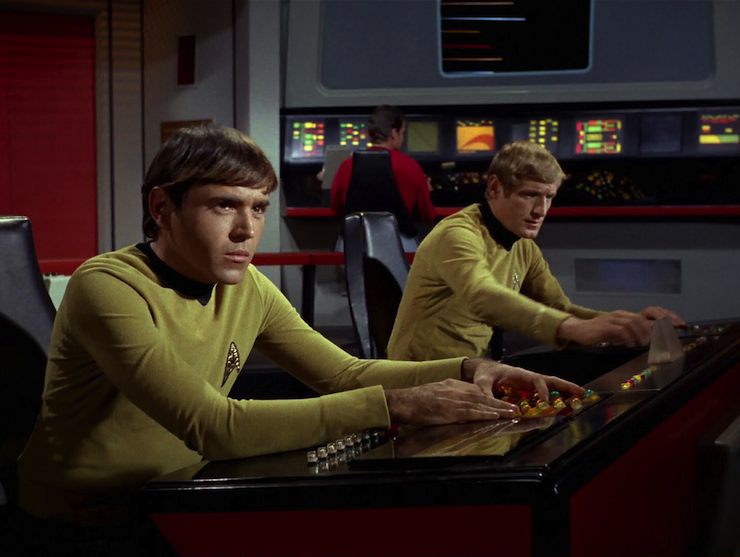
Ahead warp one, aye. Kyle gets to be the helmsman this time ’round. He wears a gold uniform so the stock footage of the navigation console with Chekov visible on the right and the right arm of the helmsman visible on the left would still work.
No sex, please, we’re Starfleet. Before the shuttle enters the amoeba’s insides, Spock warns, “The area of penetration will no doubt be sensitive.” Wah-HEY!
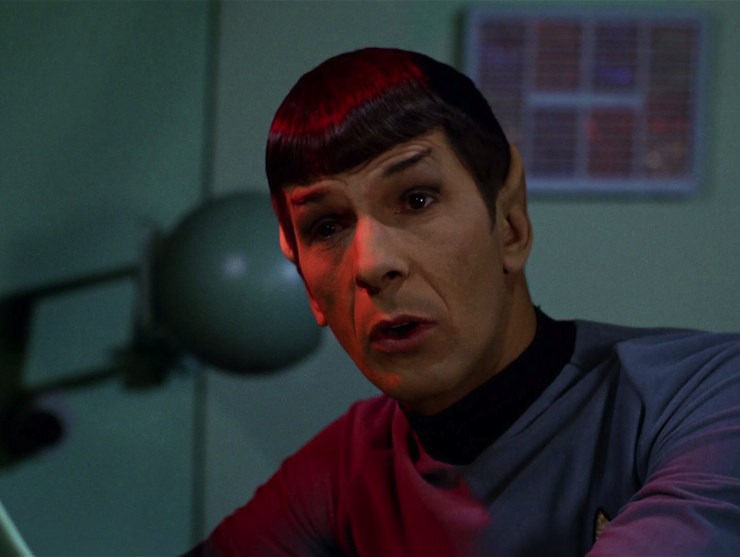
Channel open. “Captain, I recommend you abandon the attempt. Do not risk the ship further on my behalf.”
“Shut up, Spock, we’re rescuing you!”
“Why thank you—Captain McCoy.”
Spock being all heroic and self-sacrificing and stuff, McCoy snarking him off, and Spock snarking right back.
Welcome aboard. No major guest stars this time ’round, just recurring regulars James Doohan, Nichelle Nichols, Majel Barrett, Walter Koenig, and John Winston.
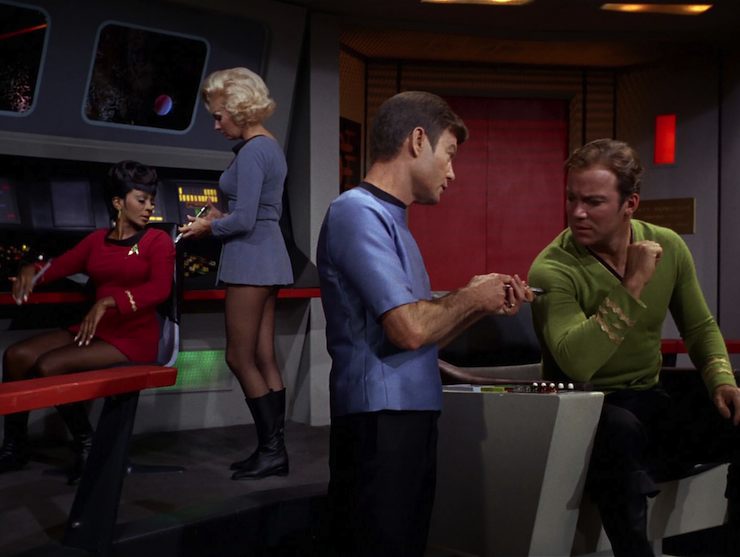
Trivial matters: This is the last time on the series that we see Kirk’s green tunic, the interior of a shuttlecraft, and an episode directed by Joseph Pevney. Pevney was brought in by Gene L. Coon to direct “Arena,” and he became one of the show’s go-to directors (he’s tied with Marc Daniels for most episodes directed). However, Pevney felt the on-set behavior of the actors went south with Coon’s departure, and so he did not come back after this one.
This is Robert Sabaroff’s only script for the original series, but he would be involved in writing two first-season TNG episodes, “Home Soil” and “Conspiracy.”
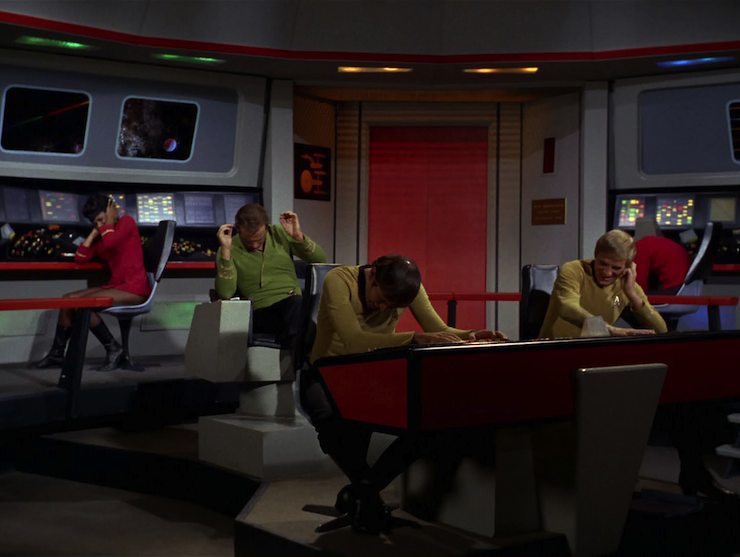
There are a lot of similarities between this episode and the TNG episode “Where Silence Has Lease,” particularly in its first half with holes in space and such.
To boldly go. “Don’t be so smart, Spock, you botched the acetylcholine test!” A surprisingly effective “bottle show,” with no guest stars, no great revelations, but a tense situation that echoes both “The Corbomite Manuever” and “Obsession,” without feeling too terribly similar to either. Although it’s probably best that this didn’t air back to back with “Obsession” originally, as they are both similar enough (non-sentient dangerous creature that is stopped by antimatter). This one comes across far better because the captain doesn’t act like an idiot.
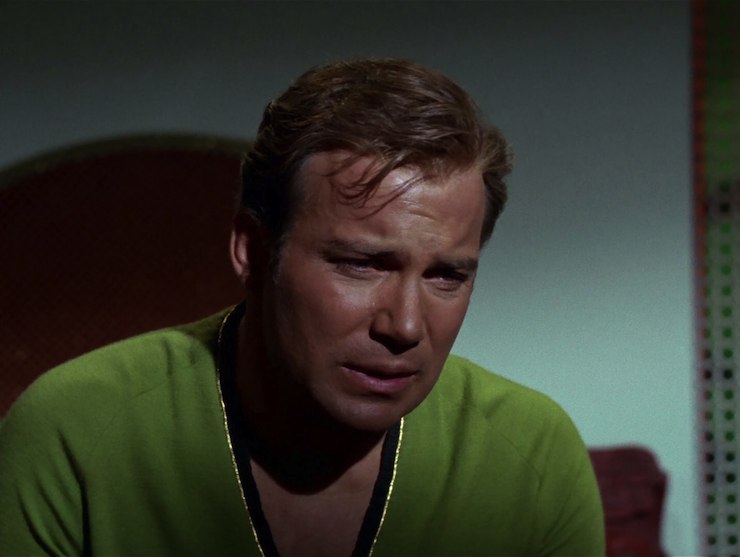
This story does reveal a pattern in this second season, though, and it’s not a great one. The first season was impressive because there were very few true monsters. The evil destroying lizards of “Arena” turned out to be a proud species of people known as the Gorn who were just defending themselves. The evil acid-spewing creature that killed the miners in “The Devil in the Dark” turned out to be a mother protecting her young. The big-ass ship with the ugly guy running that endangered the ship in “The Corbomite Maneuver” turned out to be a very weird first contact. Even the salt vampire of “The Man Trap” had an element of tragedy about it as the last of its kind. Trelane was just a kid playing with his toys, Charlie was just a kid who wanted to be loved, Kodos/Karidian was a monster and now is an old man trying to put his past behind him, the planet isn’t trying to kill them but is rather an amusement park, and so on.
This season, though, has had less of the redemptive and compassionate aspect. We still have it in places like “Friday’s Child” and especially “Metamorphosis.” But the evil energy creature who kills people in “Wolf in the Fold” is really an evil energy creature who kills people. The big thing that kills planets in “The Doomsday Machine” is really a big thing that kills planets. The cloud creature that sucks out people’s blood in “Obsession” is really a cloud creature that sucks out people’s blood. And the big-ass space amoeba that sucks energy here is just a big-ass space amoeba that sucks energy. And in all four cases, the Enterprise‘s mission is to destroy it, which is significantly less interesting than learning about it.
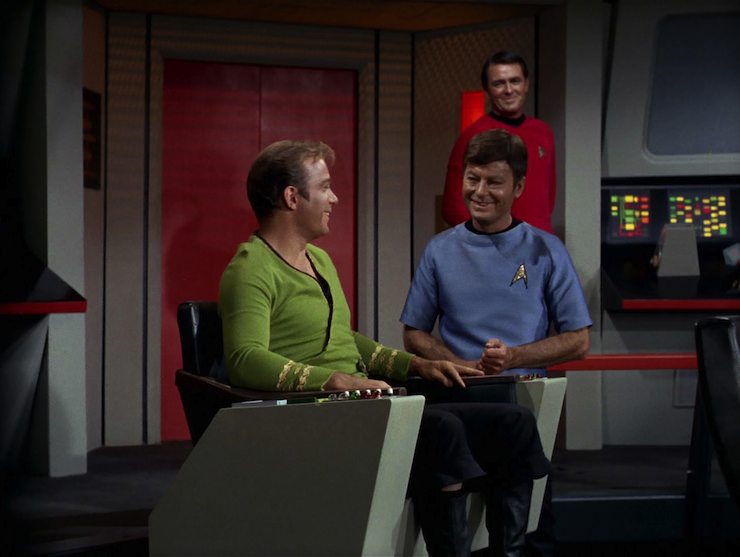
It’s only disappointing insofar as it reduces the bad guys to just monsters, moving away from the humanistic elements that made Star Trek stand out in the first place.
Having said all that, it works here, especially since the amoeba is just that—the simplest possible life form, albeit with a pituitary problem. There’s no real chance of it being intelligent, and it starts with destroying a starship and an inhabited solar system. It’s definitely something that needs to be stopped before it can reproduce.
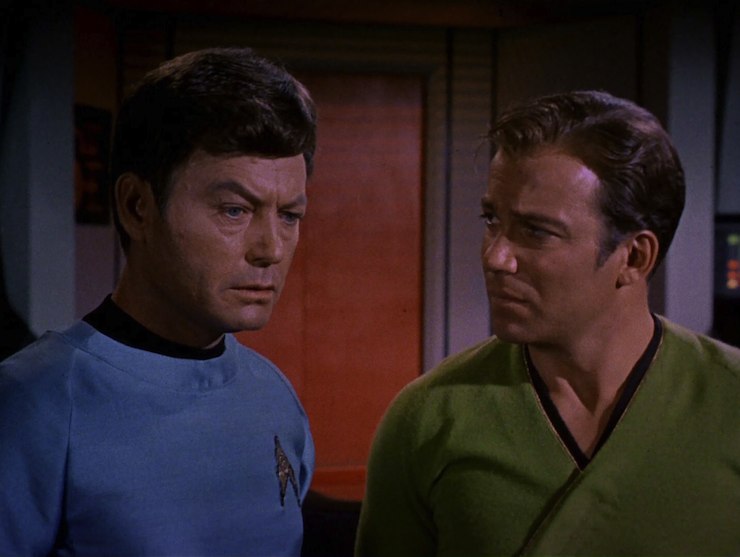
Several elements make this episode work beautifully. For starters, the crew’s exhaustion adds to the tension—both Kirk’s no-please-we-want-to-go-on-shore-leave-we’re-pooped pleading at the top of the episode combined with the amoeba draining their energy adds a miasma of fatigue to the proceedings. Notably, though, at no point does it compromise anyone’s ability to do their job. Twice the crew is referred to as the finest crew in the fleet, and no better evidence of that can be provided than the fact that they all stay at their posts and do their jobs superlatively even with all this crap being thrown at them.
And then there’s the Kirk-Spock-McCoy triad, which is at its finest here. McCoy’s enthusiasm for going on the shuttle mission and his resentment at Spock is beautifully played by DeForest Kelley, while Leonard Nimoy’s reserved snottiness is pretty much on overdrive. But you also see the underlying respect and affection they both have for each other (something less in evidence in places like “Bread and Circuses” and “The Gamesters of Triskelion,” which both could’ve used it).
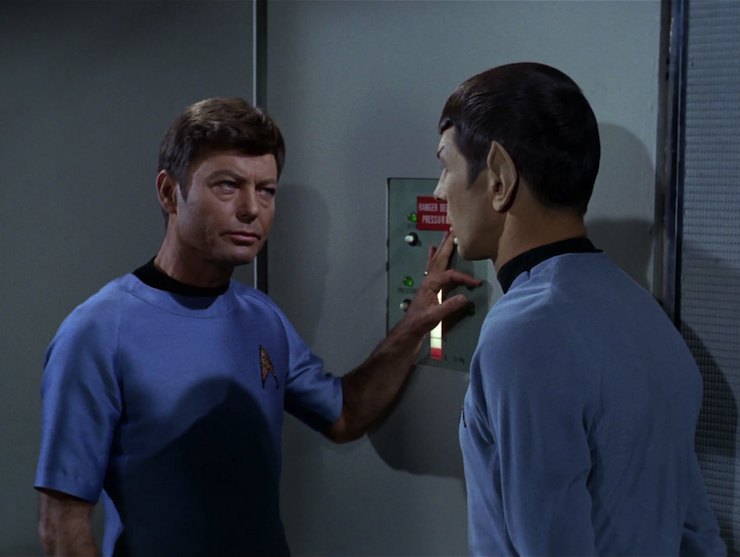
Finally, William Shatner does a really good job as the leader of all this. His agonizing over the decision of who to send is palpable, but his choice is really the only right one, as the mission truly does require someone who can remain calm and who has greater physical stamina.
Warp factor rating: 7
Next week: “A Piece of the Action”
Keith R.A. DeCandido just finished writing The Warriors Three: Godhood’s End, the third book in his Marvel’s Tales of Asgard trilogy. The first book, Thor: Dueling with Giants is available as an eBook, with the print book due this month; the second book, Sif: Even Dragons Have Their Endings, is available for preorder now.










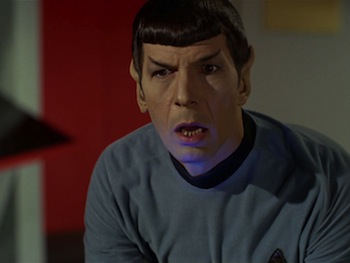
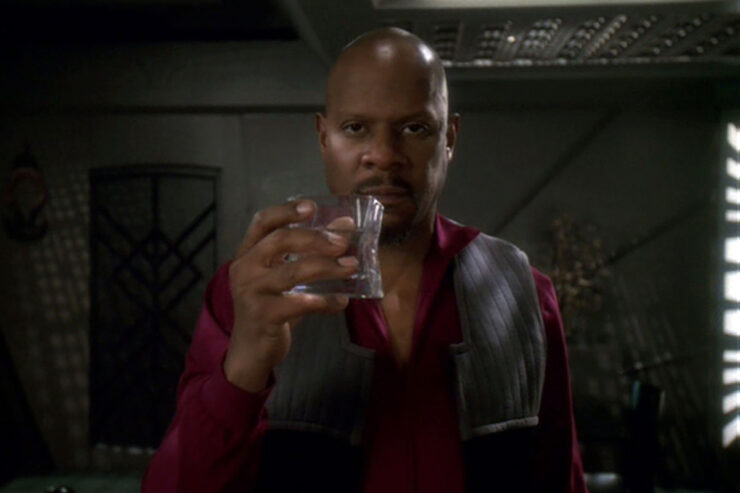
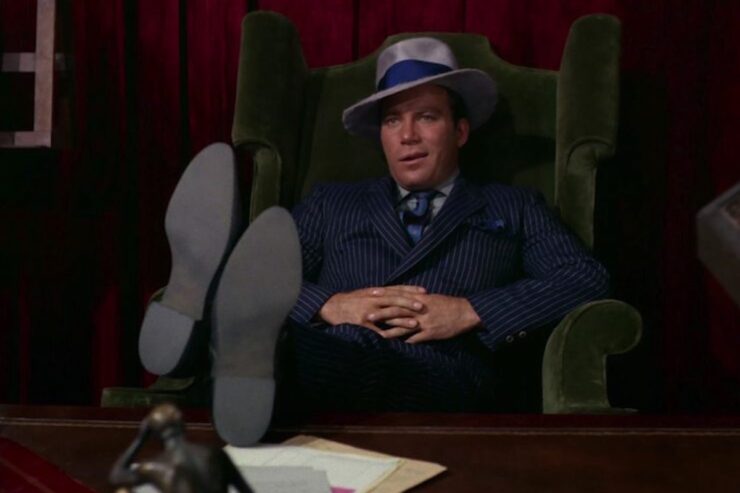
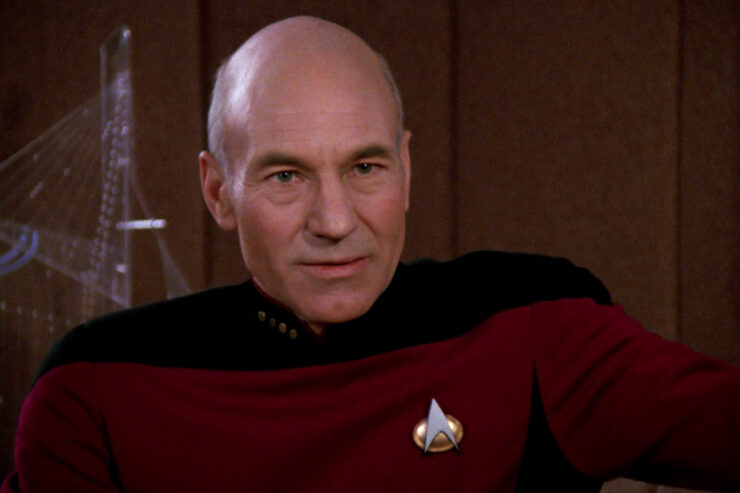

I wasn’t sure what you’d make of this one, Keith. I’ve always liked the episode for its drama and tension and character interplay, and the reuse of Sol Kaplan’s “Doomsday Machine” score adds a lot of intensity and grandeur to the proceedings, but conceptually, it’s really, really dumb. A giant amoeba in space? A zone that inexplicably drains energy and makes everything work backward? And the logic behind the antimatter thing is silly. Antimatter will destroy anything except other antimatter. Given that the ship’s armaments routinely include photon torpedoes — i.e. torpedoes with antimatter warheads — it’s kind of a no-brainer to use antimatter to destroy things, but it’s treated here as some big revelation. And Kirk’s logic doesn’t work anyway — if everything’s inverted, wouldn’t it follow that antimatter wouldn’t hurt it?
The implication that Starfleet was organized into segregated, single-race crews was a bit troubling too, though it’s not out of character for the Vulcans to have trouble playing well with others. It’s always been assumed that the Intrepid was a Constitution-class ship, but ever since Enterprise, I’ve wondered if it might actually have been a ringship of the type the Vulcans were using in the 22nd century (albeit more advanced, of course).
You mentioned the similarity to “Where Silence Has Lease.” It always bugged me in that episode that, upon seeing a zone of darkness that appeared almost exactly like the one from “The Immunity Syndrome,” Data said definitively, “There is no record of any Federation vessel encountering anything remotely like this.” That’s a pretty major continuity glitch. For a while, I wondered if maybe Roddenberry had inserted that line deliberately in order to implicitly decanonize “The Immunity Syndrome” — I gather that at that stage in his life, he’d come to regret a lot about TOS and wanted to retcon out the parts he found silly or embarrassing. But my more recent understanding is that his ill health had forced him to withdraw to more of an honorary consultant position by the second season of TNG, so he wouldn’t have been actively rewriting the scripts anymore. So maybe it really was just a continuity error, although if so, it’s surprisingly on-the-nose.
One thing I remember about this episode is that it’s one of the first Trek episodes I ever saw in color, when my family was on vacation and I got to see it on the hotel’s color TV. It must’ve been around 1979-80, because I also saw a second-season Jason of Star Command episode in color for the first time and was amazed to learn that Commander Stone had blue skin. Anyway, “The Immunity Syndrome” in color was a revelation. It was quite spectacular to behold.
Another childhood memory: A local independent station used to show Star Trek reruns and Space: 1999 episodes back-to-back, and one night, it showed Star Trek: “The Immunity Syndrome” followed by Space: 1999: “The Immunity Syndrome.” It’s weird that two different shows would use the same, rather unusual title. I mean, it’s not the kind of common word or phrase you’d expect to see as a title on multiple shows, like “The Enemy Within” or “Mirror, Mirror” or “Obsession,” say.
1/Christopher – I don’t know that one has to infer from the single example of the Intrepid that “Starfleet was organized into segregated, single-race crews.” I never did, at least. (I do agree with you, though, that after Star Trek: Enterprise, a single-race ship of Vulcans makes some sense). What does strike me now, though, is how strange it is that a ship “manned by Vulcans” (McCoy doesn’t say “entirely manned by Vulcans,” though I grant that’s the plain sense of his words… still, maybe its a majority Vulcan crew…) would be christened a word in any language other than Vulcan. Maybe that was the English translation. (Are we using “Federation Standard” at this point in Trek? Or am I just imagining there is a Trek equivalent to Star Wars’ “Basic”?)
There might be logistical arguments for single-race ships. After all, doesn’t Spock complain about the temperature aboard Enterprise sometimes? (Or is that just in novels?) I know Roddenberry’s TMP novelization has Spock reflecting about how noisy the Enterprise is (still a majority human crew at that point, despite all the cool aliens the production team invented). If Starfleet were segregating starship crews as a matter of course (and I don’t think they were), surely there would be good, non-prejudicial, non-malevolent reasons for it. (No, I would not extend this reasoning to real-life examples of segregation – I’m just sticking strictly in-universe, thinking sometimes it might be beyond reasonable accomodation to have interspecies crews. Look at how the Deltans still have to take “oaths of celibacy” to serve in Starfleet by TMP – well, at least Ilia did.)
Very good write-up, Keith, and a very good point about how TOS was devolving into monster o’ the week. I’d never noticed before, watching the episodes all out of any semblance of order in syndication as a kid.
I’ve always enjoyed the amoeba’s visual effects, both the original and the redone HD version. I assume this looked pretty groundbreaking back in 1967/68, even though it would quickly become dated thanks to the eventual release of 2001: A Space Odyssey that same year, setting new benchmarks for quality visual effects.
Immunity Syndrome is one of my favorite season 2 entries, for sure. Great character work. Great use of tension and surprisingly well paced.
My only quibble has to do with Spock’s final log, when he goes a little bit over the top in his praisal of the Enterprise’s crew. Too much for Vulcan standards. It feels written rather than natural.
I don’t really buy the explanation behind Pevney’s departure. It’s the same excuse used by Joseph Scanlan on TNG. The cast is too out of control. Why would Gene Coon leaving would affect the cast’s mood? I’d understand if it were Roddenberry quitting (as it eventually happened), but not Coon. Personally, I feel this has to do with Paramount buying Desilu and deciding to save money by cutting a day’s worth of shooting for each episode. That would be credible grounds for a director to quit the show, and I believe that was the reason Marc Daniels left the following season.
As for the trend of this season boiling down to simplifying bad guys, I can see Keith’s point. I see two reasons for this:
1. Coon attempting to back away from Roddenberry’s morality play approach and more towards brainless action-adventure.
2. They were simply running out of ideas.
@1/Christopher: I’m not so sure I agree with the decanonizing assumption. If Roddenberry felt embarassed by the space amoeba concept, he wouldn’t have hired Robert Sabaroff to pitch TNG stories. Or would he?
I prefer to assume that they simply forgot about Immunity Syndrome when writing Where Silence has Lease. Remember they made that episode in the wake of a major writer’s strike. I can see them rushing the script without proofreading. Nobody’s perfect under pressure.
Totally agree about Kirk in this episode vs Obsession. Here, the amoeba is the invader and there’s no indication of intelligence. It’s still unfortunate that we don’t get to learn more about where it came from and what it was doing but it was apparent;y just too alien to coexist with life in our universe. It’s nice to see Kirk agonizing over the possibility of being the one responsible for the death of someone, particularly a friend. He was much more cavalier about the Thetans in Obsession. Once again, it does show that Kirk rends to take things more seriously when he’s got a personal stake in things.
All in all, a nice episode for the character moments although the science is, once again, best ignored. A particularly nice bit was seeing Kyle on the bridge and him getting a shout out from Kirk to boot. It would have been nice if we’d gotten more moments like this for the recurring minor characters. Sadly, the big three tend to dominate even more in the third season.
Having ships with a majority of the crew as one race makes a lot of sense. When we had Sarak need medical attention in Journey to Babel, McCot wasn’t even sure he could do the surgery, wasn’t sure how the drug would work on a Vulcan etc. This was later rectified with the appearance of M’Benga but you’d think that your medical staff would be able to take care of the races that are serving on the ship. Now multiply that by the number of aliens we saw in TMP, some of whom don’t appear to be mammalian or even capable of breathing the same atmosphere and the problem is even more extreme. Yes, it would make a nice statement about people of different species getting along together but I’m not sure I’d be comfortable serving on a ship without adequate medical care for years at a time.
@2/Mike: Another reason for Vulcan-only ships could be that it allows them to keep Pon Farr secret.
Why is the episode called “The Immunity Syndrome”?
@3/Eduardo: I’m sceptical of your first reason, because many of the really good morality plays were written by Coon. Maybe they could afford better writers in the first season?
@2/Mike: Of course I wasn’t saying one had to infer segregation — simply that one could. An implication can be disquieting without being an unambiguous fact.
@3/Eduardo: I wouldn’t say TOS’s effects “quickly became dated.” Like I said, when I saw this episode in color for the first time in 1979-80, it still looked terrific to me, even though that was after not only 2001 but Star Wars and ST:TMP.
That makes no sense. A writer is not a story. You can be unhappy with a single idea without blacklisting its creator over it. Heck, most writers are unhappy with plenty of their own past ideas and try to retcon them away in their later work — cf. George Lucas and the Star Wars special editions, or David Gerrold’s rewrites of several of his older novels. Or, for that matter, Roddenberry himself retconning the Klingons’ appearance in TMP. Everybody who actually writes for a living will understand implicitly that even good writers have bad ideas from time to time, that failing and learning from it is an integral part of the creative process.
@5/Jana: I think the title is in reference to McCoy’s musing about the ship and crew functioning as “antibodies of our own galaxy, attacking an invading germ.” In other words, they’re functioning as the immune system of the galaxy.
The premise of the Space: 1999 episode of the same name involved a whole planet’s environment attacking the visiting humans and their ships as if fighting off an infection — although, in a very Trekkish twist, it turned out to be the work of a godlike but naive energy being that didn’t understand the harm it was causing until the hero talked to it and helped it understand.
@6/JanaJansen: I’m not denying Coon’s ability to write superb and intelligent episodes like Arena and Metamorphosis. He can definitely create thoughtful shows. But at that point, he was still learning to play on Roddenberry’s universe. By season 2, however, you can see a gradual shift towards comedy or pure action-adventure. Since Coon (and also Lucas) is responsible for every script, I’d argue it’s an intentional storytelling shift on his part.
@7: Indeed, I was stretching a bit by mixing story and writer this much.
Regardless, I still don’t think Roddenberry would deliberately insert a line in a random episode to decanonize another episode like this. And, as you’ve pointed out, he was probably not even that involved by this point. I stand by the writers’ strike situation as being the likely reason behind any season 2 production mistakes.
Quoth Eduardo: “I don’t really buy the explanation behind Pevney’s departure. It’s the same excuse used by Joseph Scanlan on TNG. The cast is too out of control. Why would Gene Coon leaving would affect the cast’s mood? I’d understand if it were Roddenberry quitting (as it eventually happened), but not Coon. Personally, I feel this has to do with Paramount buying Desilu and deciding to save money by cutting a day’s worth of shooting for each episode. That would be credible grounds for a director to quit the show, and I believe that was the reason Marc Daniels left the following season.”
I doubt that cutting shooting time would’ve been a factor for Pevney, since the whole reason why he was so prolific was because he got the shoots done faster than anyone else. But he was also specifically hired by Coon, so it’s possible that Lucas didn’t want to use him because he was Coon’s dude, and Pevney told the bickering-actors story because of sour grapes. On the other hand, it’s not like Pevney was the only one who has discussed the bickering actors of Star Trek…….
—Keith R.A. DeCandido